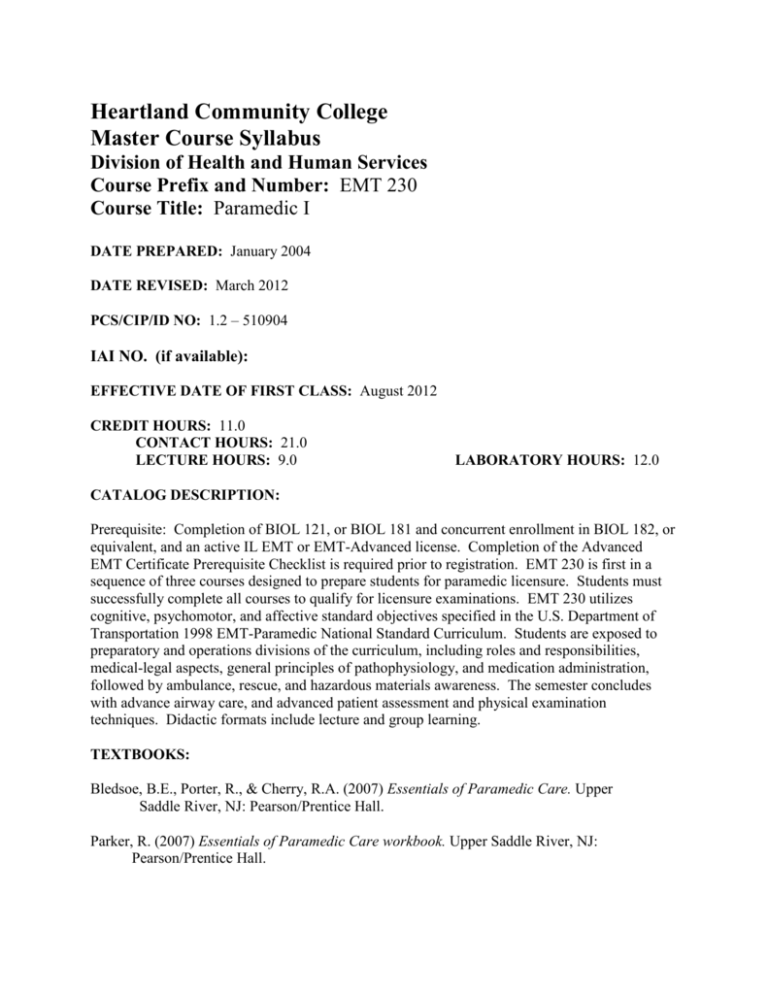
Heartland Community College
Master Course Syllabus
Division of Health and Human Services
Course Prefix and Number: EMT 230
Course Title: Paramedic I
DATE PREPARED: January 2004
DATE REVISED: March 2012
PCS/CIP/ID NO: 1.2 – 510904
IAI NO. (if available):
EFFECTIVE DATE OF FIRST CLASS: August 2012
CREDIT HOURS: 11.0
CONTACT HOURS: 21.0
LECTURE HOURS: 9.0
LABORATORY HOURS: 12.0
CATALOG DESCRIPTION:
Prerequisite: Completion of BIOL 121, or BIOL 181 and concurrent enrollment in BIOL 182, or
equivalent, and an active IL EMT or EMT-Advanced license. Completion of the Advanced
EMT Certificate Prerequisite Checklist is required prior to registration. EMT 230 is first in a
sequence of three courses designed to prepare students for paramedic licensure. Students must
successfully complete all courses to qualify for licensure examinations. EMT 230 utilizes
cognitive, psychomotor, and affective standard objectives specified in the U.S. Department of
Transportation 1998 EMT-Paramedic National Standard Curriculum. Students are exposed to
preparatory and operations divisions of the curriculum, including roles and responsibilities,
medical-legal aspects, general principles of pathophysiology, and medication administration,
followed by ambulance, rescue, and hazardous materials awareness. The semester concludes
with advance airway care, and advanced patient assessment and physical examination
techniques. Didactic formats include lecture and group learning.
TEXTBOOKS:
Bledsoe, B.E., Porter, R., & Cherry, R.A. (2007) Essentials of Paramedic Care. Upper
Saddle River, NJ: Pearson/Prentice Hall.
Parker, R. (2007) Essentials of Paramedic Care workbook. Upper Saddle River, NJ:
Pearson/Prentice Hall.
RELATIONSHIP TO ACADEMIC DEVELOPMENT PROGRAMS AND
TRANSFERABILITY:
EMT 230 was designed to meet the specific needs of an Associate of Applied Science
degree. Please see an academic advisor for an explanation concerning transfer options.
COURSE OBJECTIVES:
Students who successfully complete EMT 230 will be able to:
Course Outcomes
Describe the roles and responsibilities of a
paramedic within an emergency medical
services system.
Apply the general concepts of
pathophysiology for the assessment and
management of emergency patients.
General
Education
Outcomes
Range of Assessment Methods
Class discussion
Examination
PS2
Examination
Group presentation
Role-play scenario
Hospital- and field-based evaluations
Integrate the pathophysiological principles
of pharmacology and assessment findings to
formulate a field impression and implement
a pharmacological treatment plan.
CT2
Examination
Role-play scenario
Group presentation
Hospital- and field-based evaluations
Integrate the physiological, psychological,
and sociological changes throughout human
development with assessment and
communication strategies for patients of all
ages.
Establish and/or maintain a patent airway,
oxygenate, and ventilate a patient.
Apply a process of clinical decision making
to use assessment findings to develop a field
impression.
Integrate the principles of assessment-based
management to perform appropriate
assessments and implement management
plans for patients with common complaints.
Describe standards and guidelines that help
ensure safe and effective ground and air
medical transport.
CO5
DI2
Group presentations
Hospital- and field-based evaluations
Examination
Class discussion
Class discussion
Examination
Class discussion
Examination
Class discussion
Examination
PS2
Examination
Group presentations
Role-play scenarios
Hospital- and field-based evaluations
COURSE/LAB OUTLINE:
I.
Preparatory
A. Introduction to Advanced Pre-hospital Care
1. EMS Systems
2. Roles and Responsibilities
3. Well-Being of the Paramedic
4. Illness and Injury Prevention
5. Medical Ethics
B. Medical-Legal Aspects of Advance Pre-hospital Care
1. Legal Responsibilities
2. Paramedic-Patient Relationships
3. Resuscitation Issues
4. Crime Scenes
5. Documentation
C. General Principles of Pathophysiology
1. Physiological Responses to Disease and Injury
2. Physiological Defense Mechanisms
D. General Principles of Pharmacology
1. Basic Pharmacology
2. Drug Classifications
E. Medication Administration
1. Principles and Routes of Administration
2. Intravenous Access
3. Medical Mathematics
F. Therapeutic Communication
G. Lifespan Development
II.
Airway Management and Ventilation
A. Anatomy and Physiology Review
B. Pathophysiology
C. Respiratory Assessment
III.
Patient Assessment
A. History Taking
B. Physical Examination Techniques
C. Patient Assessment in the Field
D. Clinical Decision Making
E. Communications
F. Documentation
IV.
Operations
A. Ambulance Operations
1. Ambulance Standards
2. Maintenance and Supplies
3. Safe Driving Principles
4. Aero-Medical Transportation
B. Medical Incident Command
1. Incident Command System
2. Medical Incident Command Structure
3. Triage
4. Critical Incident Stress Management
C. Rescue Awareness and Operations
D. Hazardous Materials Incidents
1. Laws and Regulations
2. HAZMAT Identification
3. Decontamination and Emergency Management
E. Crime Scene Awareness
METHOD OF EVALUATION
Students may expect daily quizzes which serve as a means for students to improve upon overall
grade average and an instructor content monitoring mechanism. Five (5) major written and three
(3) practical examinations will be administered. Students must achieve 80% or higher on all
quizzes and examinations. A student is allowed to retake a total of two (2) written
examinations. The original examination score and the retake examination score will be averaged
and recorded. All quizzes will be averaged and recorded as one (1) examination. If a student is
absent on examination or quiz day, he/she must take it prior to the following week’s class or it
will be recorded as a zero (0). It is the student’s responsibility to make arrangements with the
Lead Instructor to retake the examination. Students who lose final examination eligibility may
complete the course for grade.
Students must pass final written and practical examinations with an 80% or higher score. One
(1) retake of any failed practical examination station will be permitted. Students must pass both
final written and practical examinations to pass the course and advance to EMT 231.
Grading Scale:
A
B
C
D
F
90-100%
80- 89%
70- 79%
60- 69%
Below 60%
REQUIRED WRITING AND READING:
Students are expected to read textbook material pertaining to each session’s content prior to that
session and according to class schedule. Written exercises may occasionally be assigned outside
the classroom, consisting primarily of ambulance call documentation.







